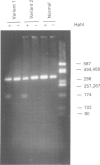Abstract
Using DNA samples obtained from two unrelated patients, diagnosed as having familial dysalbuminaemic hyperthyroxinaemia (FDH), exons 1-14 which span the entire coding region of the human serum albumin (HSA) gene were amplified by the polymerase chain reaction. The sequence of each of the 14 DNA fragments was then determined. In each case a point mutation was identified at nucleotide 653 which causes an Arg to His substitution at amino acid position 218. The substitution was confirmed by amino acid sequencing of a mutant peptide resulting from tryptic digestion of the protein. Abnormal affinity of FDH HSA for a thyroxine (T4) analogue was verified by an adaptation of the procedure used in routine free T4 measurement. The location of the mutation is discussed in relation to other studies on the binding properties of HSA.
Full text
PDF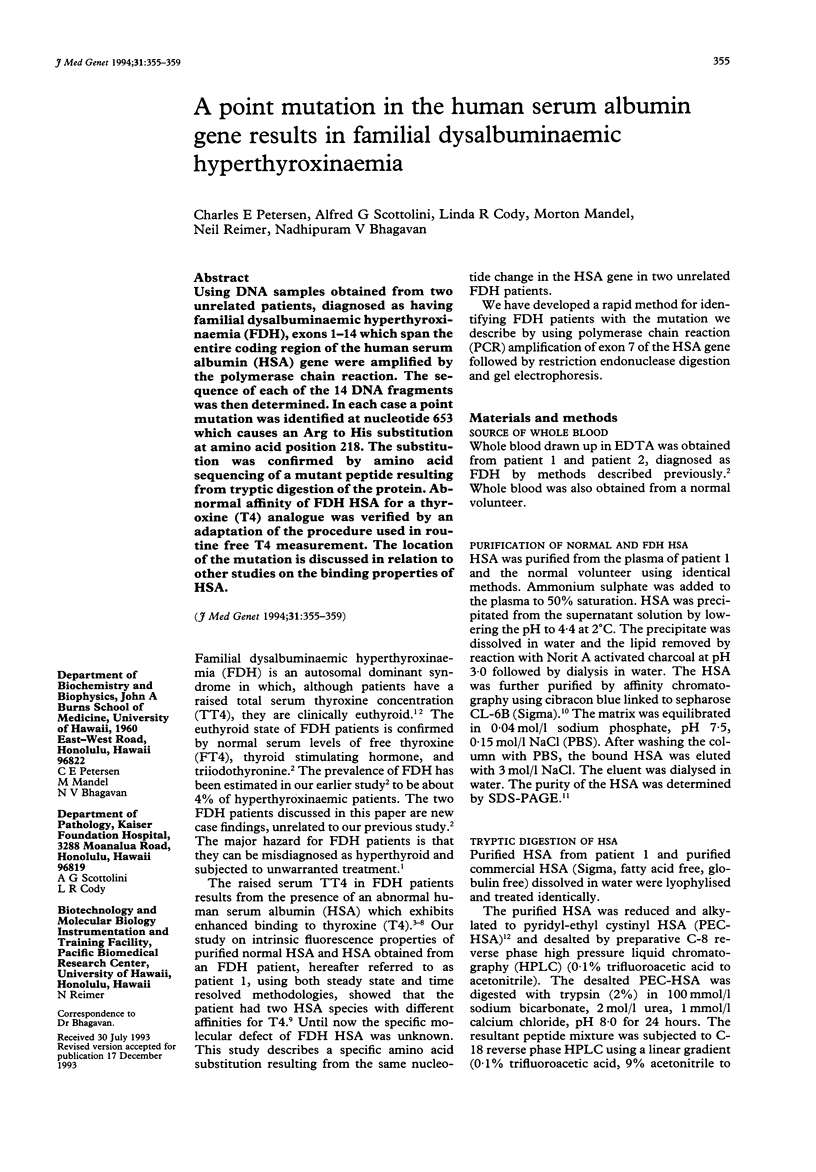
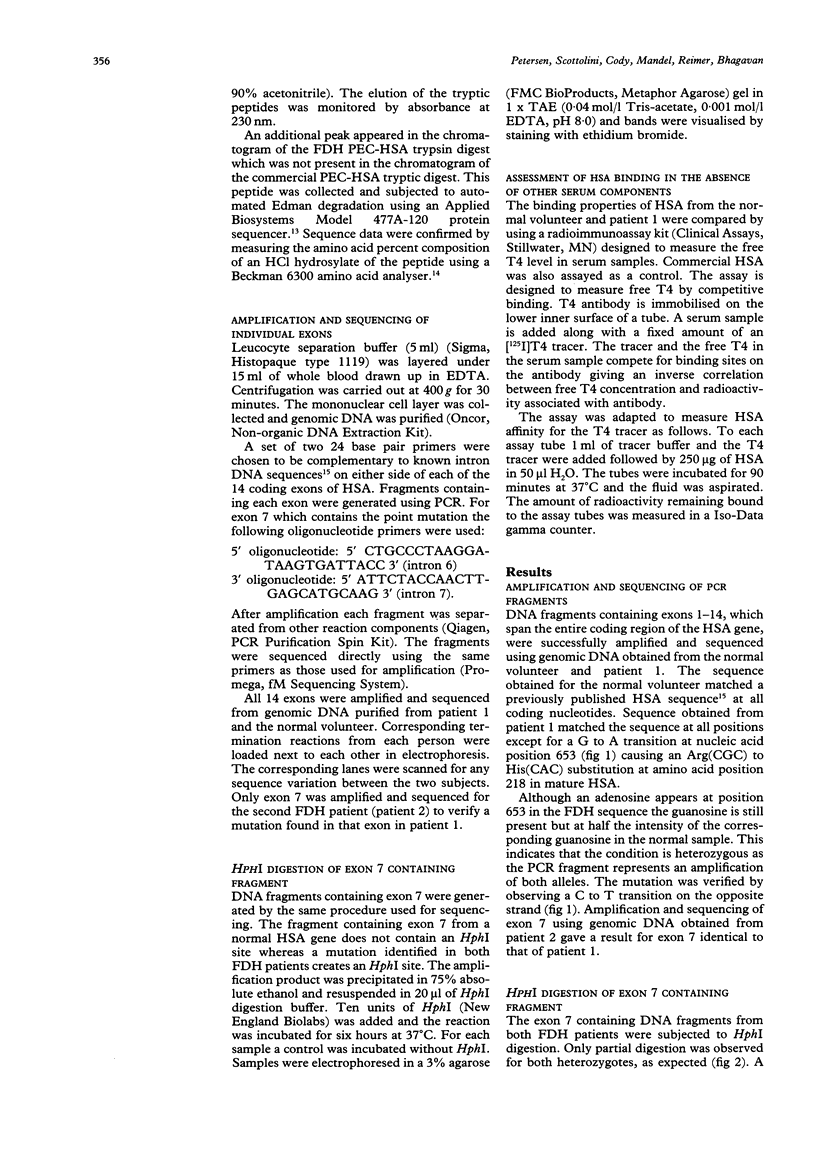
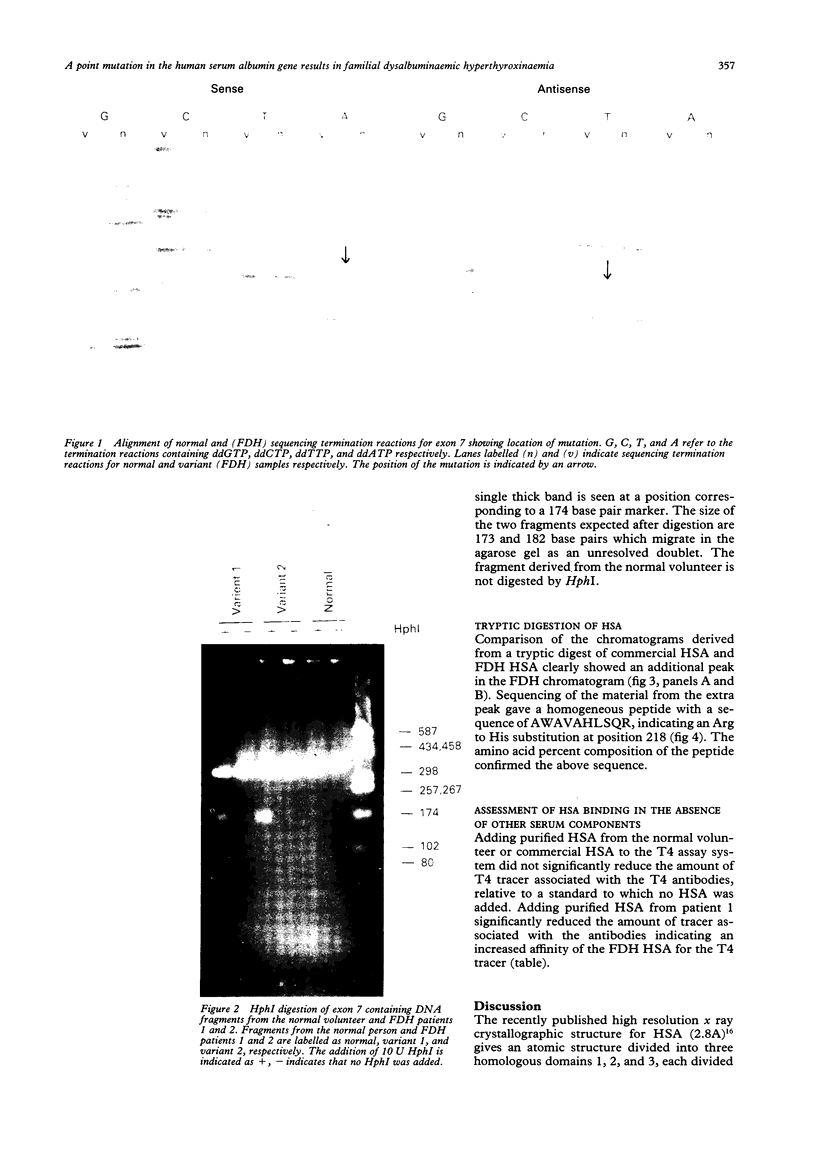
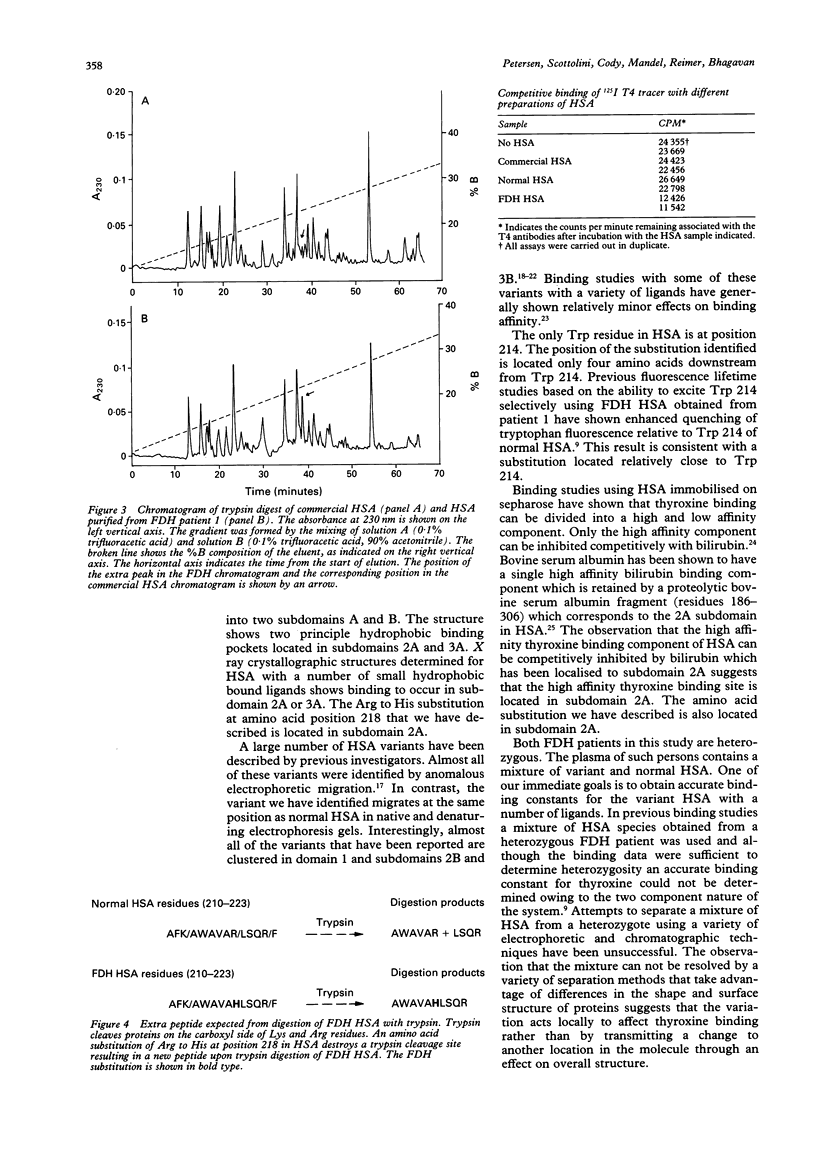
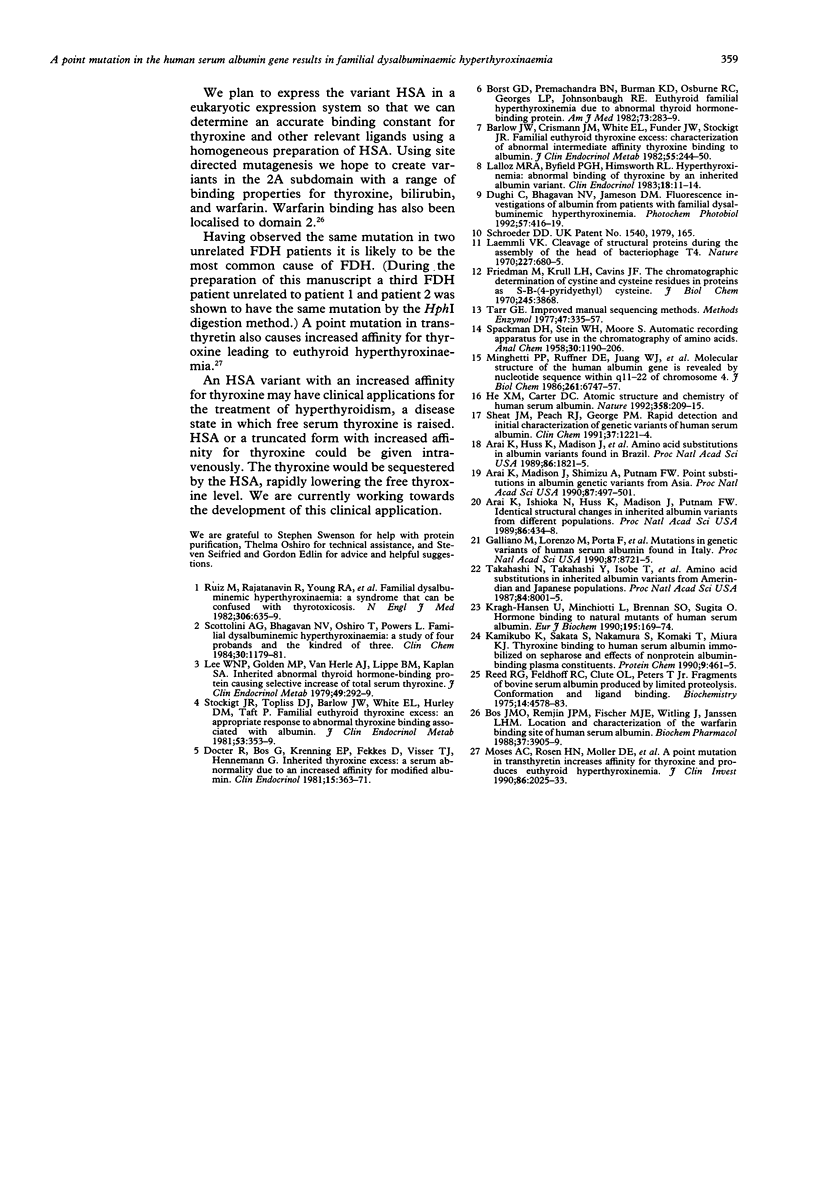
Images in this article
Selected References
These references are in PubMed. This may not be the complete list of references from this article.
- Arai K., Huss K., Madison J., Putnam F. W., Salzano F. M., Franco M. H., Santos S. E., Freitas M. J. Amino acid substitutions in albumin variants found in Brazil. Proc Natl Acad Sci U S A. 1989 Mar;86(6):1821–1825. doi: 10.1073/pnas.86.6.1821. [DOI] [PMC free article] [PubMed] [Google Scholar]
- Arai K., Ishioka N., Huss K., Madison J., Putnam F. W. Identical structural changes in inherited albumin variants from different populations. Proc Natl Acad Sci U S A. 1989 Jan;86(2):434–438. doi: 10.1073/pnas.86.2.434. [DOI] [PMC free article] [PubMed] [Google Scholar]
- Arai K., Madison J., Shimizu A., Putnam F. W. Point substitutions in albumin genetic variants from Asia. Proc Natl Acad Sci U S A. 1990 Jan;87(1):497–501. doi: 10.1073/pnas.87.1.497. [DOI] [PMC free article] [PubMed] [Google Scholar]
- Barlow J. W., Csicsmann J. M., White E. L., Funder J. W., Stockigt J. R. Familial euthyroid thyroxine excess: characterization of abnormal intermediate affinity thyroxine binding to albumin. J Clin Endocrinol Metab. 1982 Aug;55(2):244–250. doi: 10.1210/jcem-55-2-244. [DOI] [PubMed] [Google Scholar]
- Borst G. C., Premachandra B. N., Burman K. D., Osburne R. C., Georges L. P., Johnsonbaugh R. E. Euthyroid familial hyperthyroxinemia due to abnormal thyroid hormone-binding protein. Am J Med. 1982 Aug;73(2):283–289. doi: 10.1016/0002-9343(82)90190-5. [DOI] [PubMed] [Google Scholar]
- Bos O. J., Remijn J. P., Fischer M. J., Wilting J., Janssen L. H. Location and characterization of the warfarin binding site of human serum albumin. A comparative study of two large fragments. Biochem Pharmacol. 1988 Oct 15;37(20):3905–3909. doi: 10.1016/0006-2952(88)90072-x. [DOI] [PubMed] [Google Scholar]
- Docter R., Bos G., Krenning E. P., Fekkes D., Visser T. J., Hennemann G. Inherited thyroxine excess: a serum abnormality due to an increased affinity for modified albumin. Clin Endocrinol (Oxf) 1981 Oct;15(4):363–371. doi: 10.1111/j.1365-2265.1981.tb00676.x. [DOI] [PubMed] [Google Scholar]
- Dughi C., Bhagavan N. V., Jameson D. M. Fluorescence investigations of albumin from patients with familial dysalbuminemic hyperthyroxinemia. Photochem Photobiol. 1993 Mar;57(3):416–419. doi: 10.1111/j.1751-1097.1993.tb02311.x. [DOI] [PubMed] [Google Scholar]
- Friedman M., Krull L. H., Cavins J. F. The chromatographic determination of cystine and cysteine residues in proteins as s-beta-(4-pyridylethyl)cysteine. J Biol Chem. 1970 Aug 10;245(15):3868–3871. [PubMed] [Google Scholar]
- Galliano M., Minchiotti L., Porta F., Rossi A., Ferri G., Madison J., Watkins S., Putnam F. W. Mutations in genetic variants of human serum albumin found in Italy. Proc Natl Acad Sci U S A. 1990 Nov;87(22):8721–8725. doi: 10.1073/pnas.87.22.8721. [DOI] [PMC free article] [PubMed] [Google Scholar]
- He X. M., Carter D. C. Atomic structure and chemistry of human serum albumin. Nature. 1992 Jul 16;358(6383):209–215. doi: 10.1038/358209a0. [DOI] [PubMed] [Google Scholar]
- Kamikubo K., Sakata S., Nakamura S., Komaki T., Miura K. Thyroxine binding to human serum albumin immobilized on sepharose and effects of nonprotein albumin-binding plasma constituents. J Protein Chem. 1990 Aug;9(4):461–465. doi: 10.1007/BF01024622. [DOI] [PubMed] [Google Scholar]
- Kragh-Hansen U., Minchiotti L., Brennan S. O., Sugita O. Hormone binding to natural mutants of human serum albumin. Eur J Biochem. 1990 Oct 5;193(1):169–174. doi: 10.1111/j.1432-1033.1990.tb19319.x. [DOI] [PubMed] [Google Scholar]
- Laemmli U. K. Cleavage of structural proteins during the assembly of the head of bacteriophage T4. Nature. 1970 Aug 15;227(5259):680–685. doi: 10.1038/227680a0. [DOI] [PubMed] [Google Scholar]
- Lalloz M. R., Byfield P. G., Himsworth R. L. Hyperthyroxinaemia: abnormal binding of T4 by an inherited albumin variant. Clin Endocrinol (Oxf) 1983 Jan;18(1):11–24. doi: 10.1111/j.1365-2265.1983.tb03181.x. [DOI] [PubMed] [Google Scholar]
- Lee W. N., Golden M. P., Van Herle A. J., Lippe B. M., Kaplan S. A. Inherited abnormal thyroid hormone-binding protein causing selective increase of total serum thyroxine. J Clin Endocrinol Metab. 1979 Aug;49(2):292–299. doi: 10.1210/jcem-49-2-292. [DOI] [PubMed] [Google Scholar]
- Minghetti P. P., Ruffner D. E., Kuang W. J., Dennison O. E., Hawkins J. W., Beattie W. G., Dugaiczyk A. Molecular structure of the human albumin gene is revealed by nucleotide sequence within q11-22 of chromosome 4. J Biol Chem. 1986 May 25;261(15):6747–6757. [PubMed] [Google Scholar]
- Moses A. C., Rosen H. N., Moller D. E., Tsuzaki S., Haddow J. E., Lawlor J., Liepnieks J. J., Nichols W. C., Benson M. D. A point mutation in transthyretin increases affinity for thyroxine and produces euthyroid hyperthyroxinemia. J Clin Invest. 1990 Dec;86(6):2025–2033. doi: 10.1172/JCI114938. [DOI] [PMC free article] [PubMed] [Google Scholar]
- Reed R. G., Feldhoff R. C., Clute O. L., Peters T., Jr Fragments of bovine serum albumin produced by limited proteolysis. Conformation and ligand binding. Biochemistry. 1975 Oct 21;14(21):4578–4583. doi: 10.1021/bi00692a004. [DOI] [PubMed] [Google Scholar]
- Ruiz M., Rajatanavin R., Young R. A., Taylor C., Brown R., Braverman L. E., Ingbar S. H. Familial dysalbuminemic hyperthyroxinemia: a syndrome that can be confused with thyrotoxicosis. N Engl J Med. 1982 Mar 18;306(11):635–639. doi: 10.1056/NEJM198203183061103. [DOI] [PubMed] [Google Scholar]
- Sheat J. M., Peach R. J., George P. M. Rapid detection and initial characterization of genetic variants of human serum albumin. Clin Chem. 1991 Jul;37(7):1221–1224. [PubMed] [Google Scholar]
- Stockigt J. R., Topliss D. J., Barlow J. W., White E. L., Hurley D. M., Taft P. Familial euthyroid thyroxine excess: an appropriate response to abnormal thyroxine binding associated with albumin. J Clin Endocrinol Metab. 1981 Aug;53(2):353–359. doi: 10.1210/jcem-53-2-353. [DOI] [PubMed] [Google Scholar]
- Takahashi N., Takahashi Y., Isobe T., Putnam F. W., Fujita M., Satoh C., Neel J. V. Amino acid substitutions in inherited albumin variants from Amerindian and Japanese populations. Proc Natl Acad Sci U S A. 1987 Nov;84(22):8001–8005. doi: 10.1073/pnas.84.22.8001. [DOI] [PMC free article] [PubMed] [Google Scholar]
- Tarr G. E. Improved manual sequencing methods. Methods Enzymol. 1977;47:335–357. doi: 10.1016/0076-6879(77)47036-8. [DOI] [PubMed] [Google Scholar]




